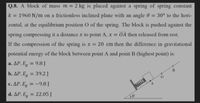Question

Transcribed Image Text:Q.8. A block of mass m = 2 kg is placed against a spring of spring constant
k :
= 1960 N/m on a frictionless inclined plane with an angle 0
= 30° to the hori-
zontal, at the equilibrium position O of the spring. The block is pushed against the
spring compressing it a distance x to point A, x OA then released from rest.
If the compression of the spring is x = 20 cm then the difference in gravitational
potential energy of the block between point A and point B (highest point) is:
a. AP. E, = 9.8J
%3D
b. AP. E, = 39.2 J
c. ΔΡ. Εg= -9.8 J
%3D
d. AP. Eg = 22.05 J
%3D
Expert Solution
This question has been solved!
Explore an expertly crafted, step-by-step solution for a thorough understanding of key concepts.
Step by stepSolved in 2 steps

Knowledge Booster
Similar questions
- A sphere of mass 7 kg is dropped fro rest from a height oh 2.8 m above the top of a spring of spring constant 1180 N/m mounted vertically on the floor . What will be the maximum compression in the spring?arrow_forwardA fully compressed spring shoots a block up a 60 degree slope. What is the max distance the block moves if: 1)There is no friction 2)Friction exists where ?k=0.3 ?=1400 N/m ?=0.2kg, ?compressed=0.1?arrow_forwardA pendulum consisting of a particle of mass m supported by a light cord of length L is released from a position ho measured from the lowest position, as shown in the figure below. The cord hits a small peg P located at a distance L/2 vertically below the upper end of the pendulum. T ho m Ohz ho g How high will the mass swing afterwards? hint: consider the conservation of energy in the system. h = ho 12 h=2 ho L harrow_forward
- A 2-kg block is attached to a spring (k = 600 N/m), where it bounces back and forth without friction. When the spring is compressed 0.1 m from equilibrium, the block has a speed of 2 m/s. What is the fastest speed the block achieves during the bouncing? Answer in m/s. [Hint: If the block only has PE and KE, how much PE will it have when it is going as fast as possible?]arrow_forwardA block of mass 5 kg has a speed of 2 m/s at a height h above a spring (spring constant k = 1000 N/m). If the spring is compressed by a max amount of 0.5 m, what is the max rebound height of the block?arrow_forwardThe 20 kg block is sliding down an inclined plane at a 30 ° inclined friction and is stopped by a spring with a spring constant k = 2 x 10 ^ 4 N / m. The block shifted to a total distance of 4 m from the point where it was released to the point where it stopped with the resistance of the spring. How many meters is the bow compressed when the block stops? (g = 10 m / s ^ 2)arrow_forward
- A block of mass m = 3.80 kg is dropped from height h = 73.0 cm onto a spring of spring constant k = 538 N/m (see the figure). Find the maximum distance the spring is compressed.arrow_forwardA toy gun fires a 9.41 g projectile disc by using a compressed spring (k= 1720 N/m). The barrel of the gun is 13.1cm (this is measured after the spring). As soon as the projectile goes leaves the spring, it creates thermal energy due to friction. The frictional force is 0.130N. If you compress the spring 14.0mm, what is the speed of the projectile when it leaves the gun?arrow_forwardA simple pendulum of lengthL=0.972m with a bob of mass m=45.8g is pulled aside untilthe bob is at a height L/4 above its equilibrium position. Thebob is then released. Find the speed of the bob as it passesthrough a point where its height is L/7 above its equilibriumposition. What is the angle the pendulum makes with thevertical at this point?arrow_forward
- A spring gun (spring constant k=100 N/m) is used to shoot a 10 g ball vertically up. Spring is compressed by 10 cm. a) What is the speed of the ball when it leaves the gun? 1. b) What is the maximum height of the ball above the release point?arrow_forwardA 306 g mass slides down a curved incline then collides with a spring. The spring constant of the spring is 156N/m. Assume that friction is negligable in these problems. If the mass initially compresses the spring at 0.63 cm, what is the maximum height the mass rises to on the incline? Assume the mass is released from rest.arrow_forwardA toy car of mass 2.0 kg starts at the top of an incline of angle 20.°. It travels 1.0 meter down the incline to a flat surface where it encounters a spring of spring constant, k = 5.0 N/m. (a) What is the car's speed at the bottom of the incline? (b) When the car encounters the spring, by how much does it compress (max) it? (c) The spring is removed and the car now encounters a second incline as shown. What is the maximum distance the car travels up this second incline?arrow_forward
arrow_back_ios
SEE MORE QUESTIONS
arrow_forward_ios